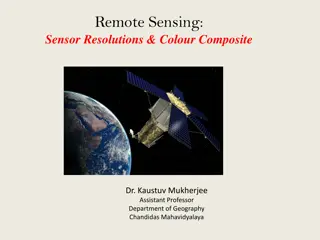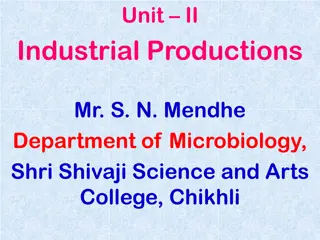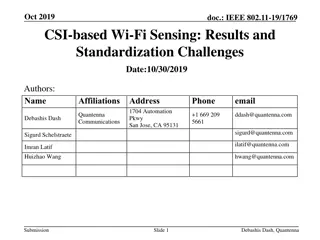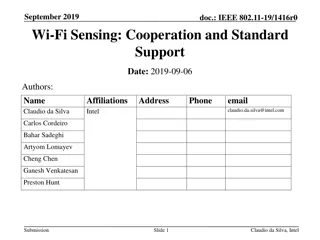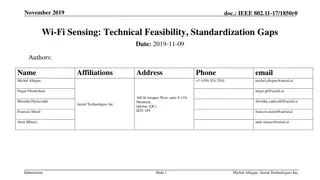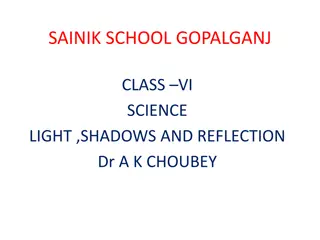Enhanced Acetone Gas Sensing with UV Light
Highly sensitive acetone gas sensors based on ZnO nanostructures are crucial for various applications. This project aims to develop a ppb-level acetone gas sensor using ZnO nanoplatelets at room temperature with the assistance of UV light irradiation. The research will focus on improving sensor performance, response value, and response/recovery time under UV light. By exploring this innovative approach, the project seeks to enhance the efficiency and practicality of acetone gas sensing technology.
Download Presentation

Please find below an Image/Link to download the presentation.
The content on the website is provided AS IS for your information and personal use only. It may not be sold, licensed, or shared on other websites without obtaining consent from the author.If you encounter any issues during the download, it is possible that the publisher has removed the file from their server.
You are allowed to download the files provided on this website for personal or commercial use, subject to the condition that they are used lawfully. All files are the property of their respective owners.
The content on the website is provided AS IS for your information and personal use only. It may not be sold, licensed, or shared on other websites without obtaining consent from the author.
E N D
Presentation Transcript
Project Title: Enhanced Acetone gas sensing performance of ZnO nanoplatelets at room temperature using UV light irradiation Highly sensitive acetone gas sensors are demanded for both clinical and environmental monitoring applications. Chemiresistive-type sensing technique is receiving attention due to the development of a low-cost, ease of manufacturing, compact design and easy-to-use measurement system is a promising solution to achieve an economically viable system to be distributed to general practitioners. Among the various metal oxide nanostructures, chemiresistive gas sensors based on ZnO nanostructures for detection of VOCs gases have been extensively developed due to their high electron mobility, excellent chemical stability and non-toxicity. However, acetone gas sensors based on ZnO nanostructures require high opertating temperature which limits their application. The assistance of UV light illumination is able to improve acetone gas sensing performance of metal oxide semiconductures at low temperature. UV light irradiation can provide additional activation energy to accelerate the interaction between the acetone gas molecules and gas sensing materials. The aim of this research is to develop highly sensitive room temperature acetone gas sensor based on ZnO nanostructures under UV light illumination. Synopsis: 1. To design and develop UV light assisted ppb-level acetone gas sensor based on ZnO nanostructures at room temperature To investigate acetone gas sensing performance of ZnO nanoplatelets at room temperature under UV light irradiation To examine the effect of UV irradiation on response value and response/recovery time of the fabricated gas sensor 2. Objectives: 3. Equipment required: Gas sensing setup, FESEM, EDX, XRD, XPS, UV-Vis and BET Software required: Microsoft excel, Origin Supervisor(Department): Prof. Dr. A. S. M. A. Haseeb (Mechanical) Master of Engineering (Materials/Mechanical) Program: Duration: Maximum 2 consecutive semesters
Project Title: In-situ study of electrochemical migration of tin in presence of weak organic acids As the pitch size in electronic packages decreases due to miniaturization, problems related to electrochemical migration (ECM) become a serious reliability concern. ECM is an electrochemical reaction that occurs in presence of electrolyte and bias voltage, causing metallic components to dissolve at the anode and redeposit at the cathode in the form of dendrites leading to short circuit failure. Contaminants originating from manufacturing process steps, flux residue and environment can accelerate the process. This work investigates ECM process of tin (Sn) in the presence of different weak organic acids, for example levulinic acid and glutaric acid by water drop test (WDT). The effects of different contaminants on the mean time to failure (MTTF) and the mechanism of ECM will be investigated. Synopsis: 1. To study the effect of various contaminants on the ECM MTTF of Sn. 2. To investigate the ECM mechanism in the presence of contaminants. 3. To improve ECM reliability of Sn in electronic interconnections. Objectives: Semiconductor Characterization System, Field Emission Scanning Electron Microscope (FESEM), Energy-dispersive X-ray spectroscopy (EDX) Equipment required: Software required: Keithley Interactive Test Environment (KITE) software Supervisor(Department): Prof. Dr. A. S. M. A. Haseeb (Mechanical) Program: Master of Materials Engineering Duration: Maximum 2 consecutive semesters
Project Title: Effect of ionic contaminants in the rainwater on the electrochemical migration of tin. Miniaturization in the electronic devices have caused serious reliability concerns related to electrochemical migration (ECM) due to the closer spacing between conduction lines. ECM is an electrochemical reaction that occurs in the presence of moisture and bias voltage, causing metallic components to dissolve at the anode and redeposit at the cathode in the form of dendrites leading to short circuit failure. During service, the electronic devices are often exposed to rainwater. Rainwater contains moisture and pollutants such as Cl , NO32 , SO42 , HCO3 and NH4+which can accelerate the ECM mechanism. This work investigates the ionic contaminants of rainwater in Kuala Lumpur, Malaysia using ion chromatography. The ECM mechanisms of tin in the presence of pollutants such as NO32 , SO42 , HCO3 and NH4+in different concentrations are systematically studied by water drop test (WDT). The characterizations of the products of ECM include FESEM/ EDX. The effects of different contaminants on the mean time to failure and the mechanism of ECM will be investigated. Synopsis: 1. 2. 3. 4. To investigate the ionic contaminants in the rainwater collected in Kuala Lumpur, Malaysia. To study the ECM mechanism of tin in rainwater. To investigate the effect of varying ionic contaminants concentration on the ECM of tin. To identify the products of ECM of tin. Objectives: Equipment required: Ion chromatography (IC) system; Semiconductor characterization system(SCS); FESEM/ EDX Software required: Kiethley Interactive Test Environment (KITE); IC Measure; Microsoft Excel Supervisor (Department): Prof. Dr. A. S. M. A. Haseeb (Mechanical) Master of Engineering (Materials/Mechanical) Program: Duration: Maximum 2 consecutive semesters
Project Title: Creep behaviour of advanced multicomponent solder alloy for electronic packages An innovative solder alloy was created recently by adding different elements Sn/Ag/Bi/Sb/Cu/Ni-X in certain percentage. This novel solder material lacks scientific data and requires a lot of characterization work to justify the reliability of it. As compared to the conventional Sn/Ag/Cu solders, the lifetime in thermal cycling test was longer in industrial report. However, creep test of dog bone shape sample of this solder under thermal aging condition according to JEDEC standard was not studied. In this research, the newly created solder will be aged under different temperature and duration, then creep tests under different applied stresses will be conducted. Besides, microstructures of the solder cross section with different test condition will be observed. Characterization and reliability of this solder will be summarized. Synopsis: 1. 2. To test the creep performance of a new solder alloy with thermal aging. To observe the microstructure changing of the solder cross section with different test conditions. To create a numerical model to predict the relationship between aging and creep behavior of this new solder alloy. Objectives: 3. Equipment required: Temperature chamber, Creep test machine, FeSEM, EDX, Grinding and polishing machine Software required: Excel, Origin Pro Supervisor (Department): Prof. A. S. M. A. Haseeb Master of Material Engineering Program: Duration: Maximum 2 consecutive semesters



